Birdfinding.info ⇒ The southern form of the Limpkin is common, widespread, and increasing in various types of wetlands across most of South America’s tropical and subtropical lowlands.
“Brown-backed Limpkin”
Aramus guarauna guarauna
Humid tropical and subtropical lowlands from Panama to Argentina.
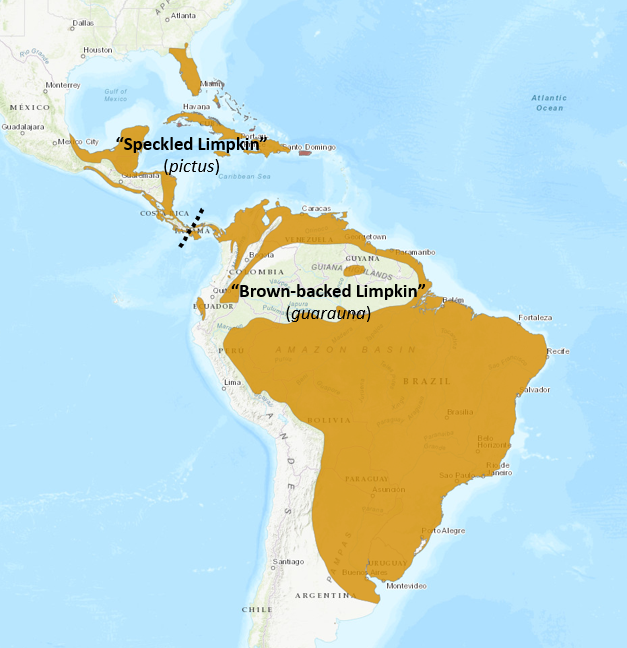
Approximate distribution of the Limpkin, both “Speckled” and “Brown-backed” forms. © BirdLife International 2016
The “Brown-backed Limpkin” is resident in lowlands from central Panama (Herrera) south along the Pacific slope to southwestern Ecuador (El Oro), and east through the Caribbean lowlands—including the intermontane valleys of Colombia—and generally throughout northern and eastern South America, south to central Argentina: to Mendoza, northern La Pampa, and southern Buenos Aires Province. Also resident on Trinidad.
An ongoing a range expansion has brought it into many areas where it was formerly unreported. Wanderers have been found increasingly often and farther from its traditional range. It has been expanding westward in the Pacific lowlands of Panama (where it seems likely to overlap with the “Speckled Limpkin” at some point in the 2020s), southward along the Pacific coast (recorded in Piura, Peru), and in many parts of the South American interior where it was traditionally unrecorded.
Vagrants have been recorded on Aruba, in the Andean highlands of southern Peru and northern Bolivia, in central Chile, and south to Argentine Patagonia (to Santa Cruz).
Identification
Distinctive: a medium-large, long-necked, long-legged, brown, ibis-like wetland bird with a habitually hunched posture.
Similar to its North and Middle American counterpart, the “Speckled Limpkin” (potential overlap mainly limited to Panama), but otherwise unlikely to be confused. The two forms are readily differentiated by the extent of streaking on the head, neck, body, and wings.
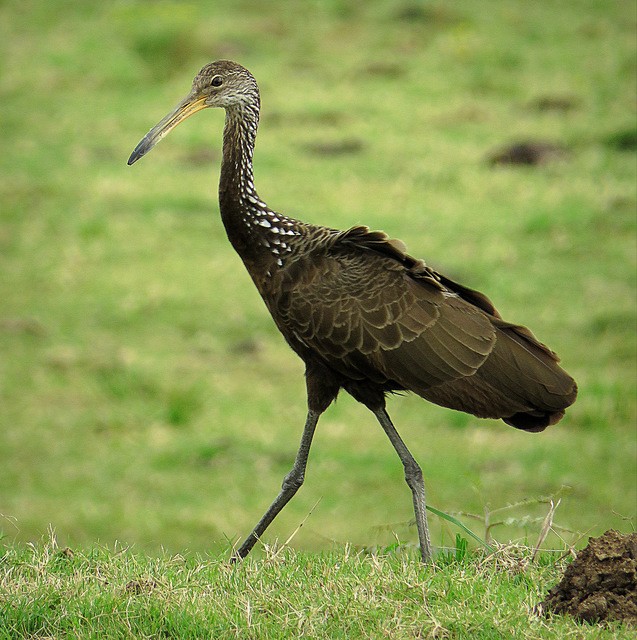
“Brown-backed Limpkin”, A. g. guarauna. (Bagé, Rio Grande do Sul, Brazil; May 24, 2017.) © Caio Belleza
The bill is long, fairly thick, and slightly decurved, usually orangish or yellowish toward the base and blackish toward the tip.
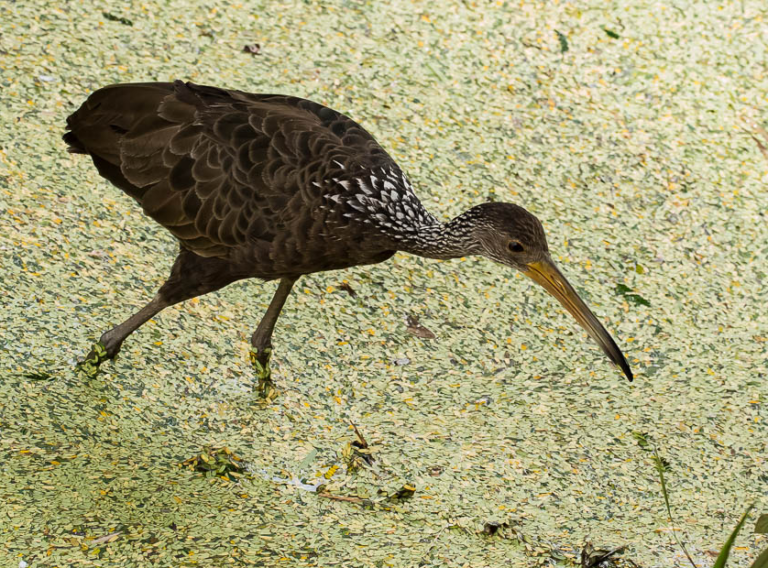
“Brown-backed Limpkin”, A. g. guarauna, showing maximum extent of streaking on the mantle. (Londrina, Paraná, Brazil; May 7, 2016.) © Luiz Bravo
The head and neck are heavily streaked white and brown, but the crown and underside of the neck are solid brown.
The body plumage is almost entirely brown, except that the white neck streaks often extend onto the mantle.
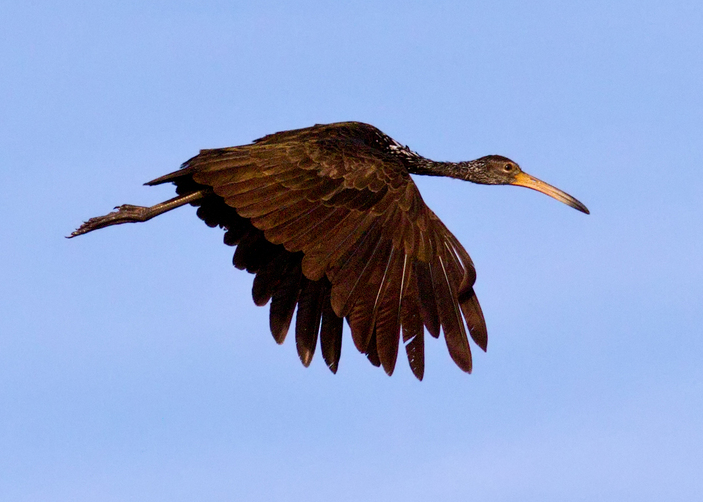
“Brown-backed Limpkin”, A. g. guarauna, dorsal view in flight, showing all-brown upperparts. (Mostardas, Rio Grande do Sul, Brazil; November 28, 2012.) © Marco Cruz
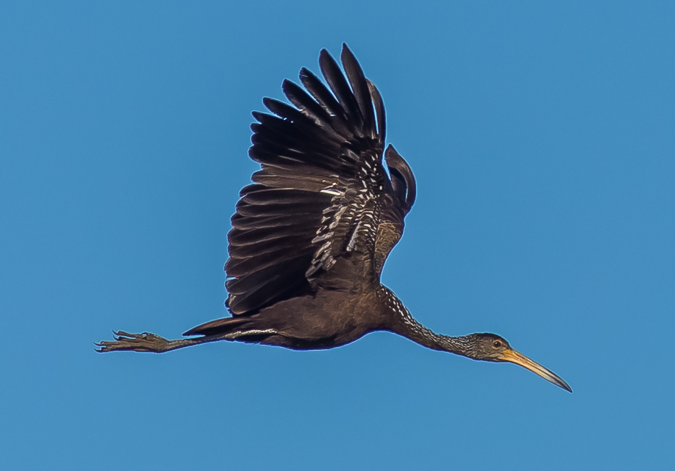
“Brown-backed Limpkin”, A. g. guarauna, ventral view in flight, showing sparse white streaks on the wing linings. (Serra, Espírito Santo, Brazil; August 24, 2014.) © Marcelo Müller
When seen in flight, the wings are mostly brown, with limited white streaking on the undersides.
Voice. The voices of the two forms are similar, and the significance of any differences between them apparently remains unstudied. Typical calls include a loud, ringing “carr-rr-rao” which is the source of its Portuguese name, Carão, often intermixed with clear single-note barks or shrieks: Sometimes honks:Or gives clear piercing screams:Or barks:Or various clucks, squeaks, and chirps:
Notes
Monotypic form, one of two distinct forms of the Limpkin.
References
Ascanio, D., G.A. Rodriguez, and R. Restall. 2017. Birds of Venezuela. Christopher Helm, London.
BirdLife International. 2016. Aramus guarauna. The IUCN Red List of Threatened Species 2016: e.T22692174A93339530. https://dx.doi.org/10.2305/IUCN.UK.2016-3.RLTS.T22692174A93339530.en. (Accessed December 15, 2022.)
de la Peña, M.R., and M. Rumboll. 1998. Birds of Southern South America and Antarctica. Princeton University Press.
eBird. 2022. eBird: An online database of bird distribution and abundance. Cornell Lab of Ornithology, Ithaca, N.Y. http://www.ebird.org. (Accessed December 15, 2022.)
Erize, F., J.R. Rodriguez Mata, and M. Rumboll. 2006. Birds of South America: Non-Passerines: Rheas to Woodpeckers. Princeton University Press.
ffrench, R. 2012. A Guide to the Birds of Trinidad & Tobago (Third Edition). Cornell University Press.
Kirwan, G.M., A. Levesque, M. Oberle, and C.J. Sharpe. 2019. Birds of the West Indies. Lynx Edicions, Barcelona.
McMullan, M., and T. Donegan. 2014, Field Guide to the Birds of Colombia (Second Edition). Fundación Proaves de Colombia, Bogotá.
Raffaele, H., J. Wiley, O. Garrido, A. Keith, and J. Raffaele. 1998. A Guide to the Birds of the West Indies. Princeton University Press.
Ridgely, R.S., and P.J. Greenfield. 2001. The Birds of Ecuador, Volume II: Field Guide. Cornell University Press.
Ridgely, R.S., and J.A. Gwynne. 1989. A Guide to the Birds of Panama (Second Edition). Princeton University Press.
Schulenberg, T.S., D.F. Stotz, D.F. Lane, J.P. O’Neill, and T.A. Parker. 2007. Birds of Peru. Princeton University Press.
van Perlo, B. 2009. A Field Guide to the Birds of Brazil. Oxford University Press.
Wells, J.V., and A.C. Wells. 2017. Birds of Aruba, Bonaire, and Curaçao. Cornell University Press.
Wikiaves. 2022. Carão, https://www.wikiaves.com.br/wiki/carao. (Accessed December 15, 2022.)
Xeno-Canto. 2022. Limpkin – Aramus guarauna. https://xeno-canto.org/species/Aramus-guarauna. (Accessed December 15, 2022.)
